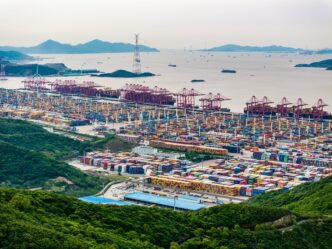On June 12, 2023, at the Novo Nordisk A/S production facilities in Hillerod, Denmark, pharmaceutical vials move steadily along a conveyor belt. The remarkable success of Novo Nordisk’s leading medications, Ozempic and Wegovy, which aid in significant weight loss, has sparked a competitive boom within the pharmaceutical industry. This has led to approximately 40 companies developing similar products, intensifying the market competition.
Denmark’s impressive economic growth, attributed largely to a significant rise in pharmaceutical exports, is predicted to decelerate this year. However, the potential threat of U.S. tariffs on the pharmaceutical industry is not expected to be a major contributing factor to this slowdown, as per the International Monetary Fund (IMF). In a recent report, the IMF projected that Denmark’s economy, which expanded by 3.7% in 2024, will see its growth rate decrease to 2.9% this year and further to 1.8% by 2026. This decline is expected amidst a general weakening in export growth, particularly in pharmaceutical goods.
The IMF highlighted that Denmark remains somewhat shielded from potential U.S. tariffs on pharmaceutical imports, as a majority of Danish pharmaceutical products are neither manufactured domestically nor pass through Danish borders. Danish pharmaceutical companies have increasingly adopted a “merchanting and processing” system, where the primary value of the medicines is tied to their intellectual property. These companies contract international manufacturers to produce and distribute their products.
Despite the U.S. being a significant trading partner, the IMF noted that exports originating in Denmark and passing through customs only account for 3% of total exports. Thus, the direct impact of U.S. tariffs on the Danish economy is expected to be minimal. Nonetheless, increased trade tensions and uncertainties in trade policy pose potential risks to Denmark’s economic outlook. Beyond 2026, medium-term growth is forecasted at around 1.5%, reflecting a maturing pharmaceutical sector and a shrinking working-age population.
Previously, IMF economists indicated that Denmark’s economic expansion was driven by an “exceptional surge” in its pharmaceutical sector, while other areas of the economy remained relatively stable. The IMF pointed to Novo Nordisk’s substantial increase in foreign demand for its diabetes and weight loss drugs, Wegovy and Ozempic, as a significant growth driver, with the company’s sales as a share of Denmark’s GDP rising from 1% in the early 1990s to 8.3% in 2023.
Meanwhile, the broader European pharmaceutical industry faces a significant challenge due to U.S. President Donald Trump’s threat to impose tariffs on drug imports. Although pharmaceuticals were initially exempt from Trump’s “reciprocal” tariffs regime announced in April, he has since focused on the global industry, threatening additional levies on pharmaceuticals exported to the U.S. and pressing for reductions in U.S. drug prices.
Trump recently reinforced his stance by signing an executive order compelling drugmakers to lower their prices to match the significantly lower prices paid abroad. While no specific countries were targeted, it was implied that other developed nations would be the focus. This move is part of a broader strategy to “equalize” drug pricing globally.
Despite the lack of details on which medications the order will affect, it is expected to impact both the commercial market and government programs like Medicare and Medicaid. According to data from the U.S. Department of Health & Human Services, U.S. drug prices in 2022 were nearly triple those in 33 OECD comparison countries.
The looming threat of tariffs has been likened to a “sword of Damocles” over the European pharmaceutical industry, with CEOs warning of a potential exodus of major continental players to the U.S. to avoid these levies. The European Federation of Pharmaceutical Industries and Associations (EFPIA), representing major European pharmaceutical firms including Novo Nordisk, Bayer, and AstraZeneca, cautioned European Commission President Ursula von der Leyen that without rapid policy changes, pharmaceutical research, development, and manufacturing may increasingly shift to the U.S.
EFPIA reported that a survey of its members indicated that approximately 100 billion euros ($112 billion) in capital expenditure and R&D investments are at risk. The U.S. currently surpasses Europe across all investor metrics, from capital availability to innovation rewards, reducing incentives to invest in the EU and encouraging relocation to the U.S.








